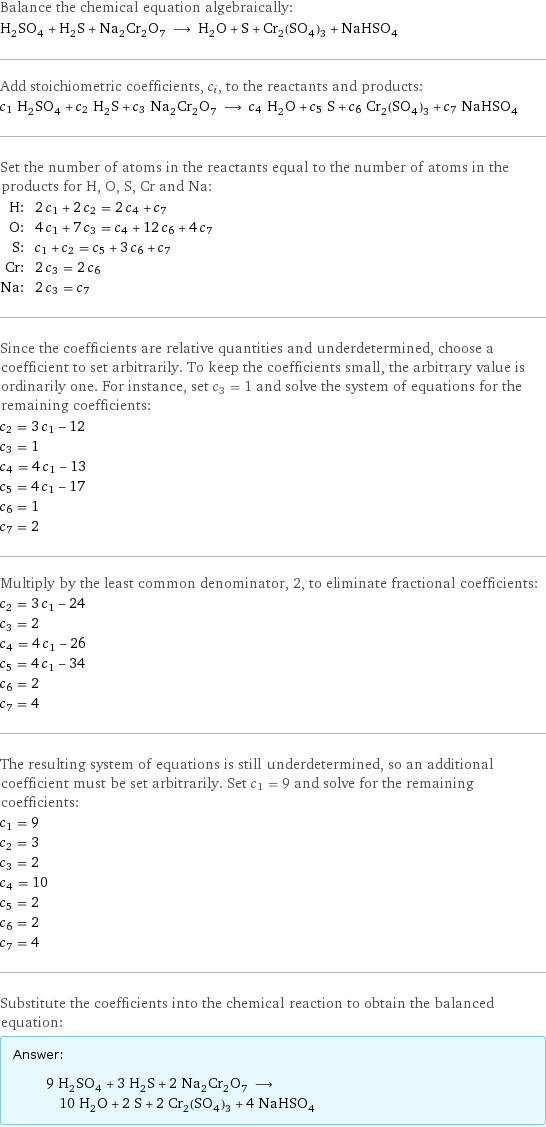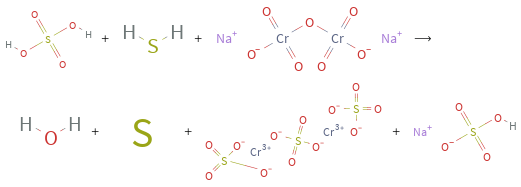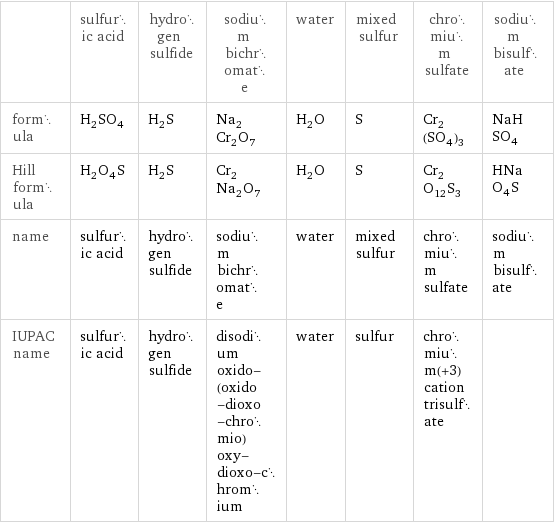Input interpretation

H_2SO_4 sulfuric acid + H_2S hydrogen sulfide + Na_2Cr_2O_7 sodium bichromate ⟶ H_2O water + S mixed sulfur + Cr_2(SO_4)_3 chromium sulfate + NaHSO_4 sodium bisulfate
Balanced equation

Balance the chemical equation algebraically: H_2SO_4 + H_2S + Na_2Cr_2O_7 ⟶ H_2O + S + Cr_2(SO_4)_3 + NaHSO_4 Add stoichiometric coefficients, c_i, to the reactants and products: c_1 H_2SO_4 + c_2 H_2S + c_3 Na_2Cr_2O_7 ⟶ c_4 H_2O + c_5 S + c_6 Cr_2(SO_4)_3 + c_7 NaHSO_4 Set the number of atoms in the reactants equal to the number of atoms in the products for H, O, S, Cr and Na: H: | 2 c_1 + 2 c_2 = 2 c_4 + c_7 O: | 4 c_1 + 7 c_3 = c_4 + 12 c_6 + 4 c_7 S: | c_1 + c_2 = c_5 + 3 c_6 + c_7 Cr: | 2 c_3 = 2 c_6 Na: | 2 c_3 = c_7 Since the coefficients are relative quantities and underdetermined, choose a coefficient to set arbitrarily. To keep the coefficients small, the arbitrary value is ordinarily one. For instance, set c_3 = 1 and solve the system of equations for the remaining coefficients: c_2 = 3 c_1 - 12 c_3 = 1 c_4 = 4 c_1 - 13 c_5 = 4 c_1 - 17 c_6 = 1 c_7 = 2 Multiply by the least common denominator, 2, to eliminate fractional coefficients: c_2 = 3 c_1 - 24 c_3 = 2 c_4 = 4 c_1 - 26 c_5 = 4 c_1 - 34 c_6 = 2 c_7 = 4 The resulting system of equations is still underdetermined, so an additional coefficient must be set arbitrarily. Set c_1 = 9 and solve for the remaining coefficients: c_1 = 9 c_2 = 3 c_3 = 2 c_4 = 10 c_5 = 2 c_6 = 2 c_7 = 4 Substitute the coefficients into the chemical reaction to obtain the balanced equation: Answer: | | 9 H_2SO_4 + 3 H_2S + 2 Na_2Cr_2O_7 ⟶ 10 H_2O + 2 S + 2 Cr_2(SO_4)_3 + 4 NaHSO_4
Structures

+ + ⟶ + + +
Names

sulfuric acid + hydrogen sulfide + sodium bichromate ⟶ water + mixed sulfur + chromium sulfate + sodium bisulfate
Equilibrium constant
![Construct the equilibrium constant, K, expression for: H_2SO_4 + H_2S + Na_2Cr_2O_7 ⟶ H_2O + S + Cr_2(SO_4)_3 + NaHSO_4 Plan: • Balance the chemical equation. • Determine the stoichiometric numbers. • Assemble the activity expression for each chemical species. • Use the activity expressions to build the equilibrium constant expression. Write the balanced chemical equation: 9 H_2SO_4 + 3 H_2S + 2 Na_2Cr_2O_7 ⟶ 10 H_2O + 2 S + 2 Cr_2(SO_4)_3 + 4 NaHSO_4 Assign stoichiometric numbers, ν_i, using the stoichiometric coefficients, c_i, from the balanced chemical equation in the following manner: ν_i = -c_i for reactants and ν_i = c_i for products: chemical species | c_i | ν_i H_2SO_4 | 9 | -9 H_2S | 3 | -3 Na_2Cr_2O_7 | 2 | -2 H_2O | 10 | 10 S | 2 | 2 Cr_2(SO_4)_3 | 2 | 2 NaHSO_4 | 4 | 4 Assemble the activity expressions accounting for the state of matter and ν_i: chemical species | c_i | ν_i | activity expression H_2SO_4 | 9 | -9 | ([H2SO4])^(-9) H_2S | 3 | -3 | ([H2S])^(-3) Na_2Cr_2O_7 | 2 | -2 | ([Na2Cr2O7])^(-2) H_2O | 10 | 10 | ([H2O])^10 S | 2 | 2 | ([S])^2 Cr_2(SO_4)_3 | 2 | 2 | ([Cr2(SO4)3])^2 NaHSO_4 | 4 | 4 | ([NaHSO4])^4 The equilibrium constant symbol in the concentration basis is: K_c Mulitply the activity expressions to arrive at the K_c expression: Answer: | | K_c = ([H2SO4])^(-9) ([H2S])^(-3) ([Na2Cr2O7])^(-2) ([H2O])^10 ([S])^2 ([Cr2(SO4)3])^2 ([NaHSO4])^4 = (([H2O])^10 ([S])^2 ([Cr2(SO4)3])^2 ([NaHSO4])^4)/(([H2SO4])^9 ([H2S])^3 ([Na2Cr2O7])^2)](../image_source/777d0aa80fed353146e07502db2ed098.png)
Construct the equilibrium constant, K, expression for: H_2SO_4 + H_2S + Na_2Cr_2O_7 ⟶ H_2O + S + Cr_2(SO_4)_3 + NaHSO_4 Plan: • Balance the chemical equation. • Determine the stoichiometric numbers. • Assemble the activity expression for each chemical species. • Use the activity expressions to build the equilibrium constant expression. Write the balanced chemical equation: 9 H_2SO_4 + 3 H_2S + 2 Na_2Cr_2O_7 ⟶ 10 H_2O + 2 S + 2 Cr_2(SO_4)_3 + 4 NaHSO_4 Assign stoichiometric numbers, ν_i, using the stoichiometric coefficients, c_i, from the balanced chemical equation in the following manner: ν_i = -c_i for reactants and ν_i = c_i for products: chemical species | c_i | ν_i H_2SO_4 | 9 | -9 H_2S | 3 | -3 Na_2Cr_2O_7 | 2 | -2 H_2O | 10 | 10 S | 2 | 2 Cr_2(SO_4)_3 | 2 | 2 NaHSO_4 | 4 | 4 Assemble the activity expressions accounting for the state of matter and ν_i: chemical species | c_i | ν_i | activity expression H_2SO_4 | 9 | -9 | ([H2SO4])^(-9) H_2S | 3 | -3 | ([H2S])^(-3) Na_2Cr_2O_7 | 2 | -2 | ([Na2Cr2O7])^(-2) H_2O | 10 | 10 | ([H2O])^10 S | 2 | 2 | ([S])^2 Cr_2(SO_4)_3 | 2 | 2 | ([Cr2(SO4)3])^2 NaHSO_4 | 4 | 4 | ([NaHSO4])^4 The equilibrium constant symbol in the concentration basis is: K_c Mulitply the activity expressions to arrive at the K_c expression: Answer: | | K_c = ([H2SO4])^(-9) ([H2S])^(-3) ([Na2Cr2O7])^(-2) ([H2O])^10 ([S])^2 ([Cr2(SO4)3])^2 ([NaHSO4])^4 = (([H2O])^10 ([S])^2 ([Cr2(SO4)3])^2 ([NaHSO4])^4)/(([H2SO4])^9 ([H2S])^3 ([Na2Cr2O7])^2)
Rate of reaction
![Construct the rate of reaction expression for: H_2SO_4 + H_2S + Na_2Cr_2O_7 ⟶ H_2O + S + Cr_2(SO_4)_3 + NaHSO_4 Plan: • Balance the chemical equation. • Determine the stoichiometric numbers. • Assemble the rate term for each chemical species. • Write the rate of reaction expression. Write the balanced chemical equation: 9 H_2SO_4 + 3 H_2S + 2 Na_2Cr_2O_7 ⟶ 10 H_2O + 2 S + 2 Cr_2(SO_4)_3 + 4 NaHSO_4 Assign stoichiometric numbers, ν_i, using the stoichiometric coefficients, c_i, from the balanced chemical equation in the following manner: ν_i = -c_i for reactants and ν_i = c_i for products: chemical species | c_i | ν_i H_2SO_4 | 9 | -9 H_2S | 3 | -3 Na_2Cr_2O_7 | 2 | -2 H_2O | 10 | 10 S | 2 | 2 Cr_2(SO_4)_3 | 2 | 2 NaHSO_4 | 4 | 4 The rate term for each chemical species, B_i, is 1/ν_i(Δ[B_i])/(Δt) where [B_i] is the amount concentration and t is time: chemical species | c_i | ν_i | rate term H_2SO_4 | 9 | -9 | -1/9 (Δ[H2SO4])/(Δt) H_2S | 3 | -3 | -1/3 (Δ[H2S])/(Δt) Na_2Cr_2O_7 | 2 | -2 | -1/2 (Δ[Na2Cr2O7])/(Δt) H_2O | 10 | 10 | 1/10 (Δ[H2O])/(Δt) S | 2 | 2 | 1/2 (Δ[S])/(Δt) Cr_2(SO_4)_3 | 2 | 2 | 1/2 (Δ[Cr2(SO4)3])/(Δt) NaHSO_4 | 4 | 4 | 1/4 (Δ[NaHSO4])/(Δt) (for infinitesimal rate of change, replace Δ with d) Set the rate terms equal to each other to arrive at the rate expression: Answer: | | rate = -1/9 (Δ[H2SO4])/(Δt) = -1/3 (Δ[H2S])/(Δt) = -1/2 (Δ[Na2Cr2O7])/(Δt) = 1/10 (Δ[H2O])/(Δt) = 1/2 (Δ[S])/(Δt) = 1/2 (Δ[Cr2(SO4)3])/(Δt) = 1/4 (Δ[NaHSO4])/(Δt) (assuming constant volume and no accumulation of intermediates or side products)](../image_source/7384a3282daf3b177c5600fa1151f0c1.png)
Construct the rate of reaction expression for: H_2SO_4 + H_2S + Na_2Cr_2O_7 ⟶ H_2O + S + Cr_2(SO_4)_3 + NaHSO_4 Plan: • Balance the chemical equation. • Determine the stoichiometric numbers. • Assemble the rate term for each chemical species. • Write the rate of reaction expression. Write the balanced chemical equation: 9 H_2SO_4 + 3 H_2S + 2 Na_2Cr_2O_7 ⟶ 10 H_2O + 2 S + 2 Cr_2(SO_4)_3 + 4 NaHSO_4 Assign stoichiometric numbers, ν_i, using the stoichiometric coefficients, c_i, from the balanced chemical equation in the following manner: ν_i = -c_i for reactants and ν_i = c_i for products: chemical species | c_i | ν_i H_2SO_4 | 9 | -9 H_2S | 3 | -3 Na_2Cr_2O_7 | 2 | -2 H_2O | 10 | 10 S | 2 | 2 Cr_2(SO_4)_3 | 2 | 2 NaHSO_4 | 4 | 4 The rate term for each chemical species, B_i, is 1/ν_i(Δ[B_i])/(Δt) where [B_i] is the amount concentration and t is time: chemical species | c_i | ν_i | rate term H_2SO_4 | 9 | -9 | -1/9 (Δ[H2SO4])/(Δt) H_2S | 3 | -3 | -1/3 (Δ[H2S])/(Δt) Na_2Cr_2O_7 | 2 | -2 | -1/2 (Δ[Na2Cr2O7])/(Δt) H_2O | 10 | 10 | 1/10 (Δ[H2O])/(Δt) S | 2 | 2 | 1/2 (Δ[S])/(Δt) Cr_2(SO_4)_3 | 2 | 2 | 1/2 (Δ[Cr2(SO4)3])/(Δt) NaHSO_4 | 4 | 4 | 1/4 (Δ[NaHSO4])/(Δt) (for infinitesimal rate of change, replace Δ with d) Set the rate terms equal to each other to arrive at the rate expression: Answer: | | rate = -1/9 (Δ[H2SO4])/(Δt) = -1/3 (Δ[H2S])/(Δt) = -1/2 (Δ[Na2Cr2O7])/(Δt) = 1/10 (Δ[H2O])/(Δt) = 1/2 (Δ[S])/(Δt) = 1/2 (Δ[Cr2(SO4)3])/(Δt) = 1/4 (Δ[NaHSO4])/(Δt) (assuming constant volume and no accumulation of intermediates or side products)
Chemical names and formulas

| sulfuric acid | hydrogen sulfide | sodium bichromate | water | mixed sulfur | chromium sulfate | sodium bisulfate formula | H_2SO_4 | H_2S | Na_2Cr_2O_7 | H_2O | S | Cr_2(SO_4)_3 | NaHSO_4 Hill formula | H_2O_4S | H_2S | Cr_2Na_2O_7 | H_2O | S | Cr_2O_12S_3 | HNaO_4S name | sulfuric acid | hydrogen sulfide | sodium bichromate | water | mixed sulfur | chromium sulfate | sodium bisulfate IUPAC name | sulfuric acid | hydrogen sulfide | disodium oxido-(oxido-dioxo-chromio)oxy-dioxo-chromium | water | sulfur | chromium(+3) cation trisulfate |